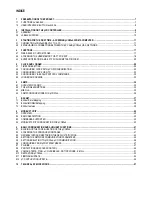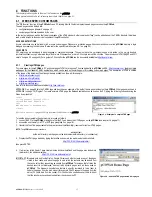
pCOWeb
+030220966 – rel. 1.1 – 12.12.2017
7
PREAMBLE
This manual has been designed with care to allow the detailed use of the product. Please do not hesitate to contact CAREL Industries S.r.l with any
information on imprecision, oversights or suggestions for easier understanding; your suggestions will help improve the quality of the following editions of this
document. Contact:
.
1
PRESENTATION OF THE PRODUCT
pCOWeb
– order code PCO1***WDØ - is an accessory for the
pCO
*
series products (excluding the
pCOB*
series) and more in general for CAREL products
fitted with a serial port and communication via the “CAREL supervisor” data protocol.
pCOWeb
acts a “gateway”, that is, a translator between the “CAREL
supervisor” data protocol and the Ethernet network protocols commonly used to connect the computers in a building. On the
pCO
*
series products it is installed
on the “Serial board” port (also called “serial card” or “BMS"), from where it also receives the power required for operation. The cover supplied protects
pCOWeb
,
especially when removing the network connector. The
pCOWeb
firmware can also be updated by the user.
Figure 1.a - pCOWeb: example of network connection
This manual refers to firmware version A2.0.4 – B2.0.4. To check the version loaded on the
pCOWeb
, see Section 9.2.2 on page 42. In the example shown in
Figure 1.a
sopra
pCOWeb
is connected to an internal network. If suitably configured, the personal computers in the internal network can communicate with
pCOWeb
using one of the various standard network languages included on
pCOWeb
. The server connects the external network or “Internet” to the internal
network or “Intranet”. Usually in a network, the exchange of data between Internet-Intranet is only enabled for some devices and only for some types of
communication. These decisions are defined by the network administrator. This manual only covers the configurations of the
pCOWeb
and the more simple
types of networks. For further information, see specific publications on the topic of “data networks”.
1.1
FUNCTIONS AVAILABLE
pCOWeb
connected to an Ethernet network provides the following functions:
WEB server
: used to check or change the operating status of the
pCO
controller using a remote computer running, for example, Mozilla Firefox, Google
Chrome or Microsoft Edge; dynamic web pages developed by the user can be added; supports CGI and Ajax technologies; supports protection for
accessing web pages;
•
Logger
:
pCOWeb
can record the values of some of the
pCO
controller variables in a file on its non-volatile memory; the file can then be downloaded to a
PC using your browser;
•
Graphs
: the trends over time of the data saved with the Logger function can be viewed on graphs;
•
:
pCOWeb
can send e-mails when programmable events occur on the
pCO
controller (activation of alarms, exceeding of thresholds) or at set time
intervals; a file in XML format can be attached containing the values of the variables;
•
FTP PUSH
:
pCOWeb
can send a file in XML format containing values of the variables to a suitably configured computer; the send operations can be
programmed in the same way as for send the e-mail messages (upon event or at set times); the file is sent using the FTP protocol;
•
SNMPv1 & v2
: to access
pCOWeb
from a computer using supervision software based on the SNMP protocol.
pCOWeb
can send programmable
enterprise TRAP or INFORM packets for alarm notifications;
•
MODBus TCP/IP:
pCOWeb
supplies information to a MODBus master requesting it over TCP/IP;
•
BACnet/IP (Addendum A/Annex J)
: for access using supervision software based on the BACnet/IP protocol;
•
BACnet Ethernet ISO8802-2 over 8802-3
: to access the
pCO
controller using supervision software based on the BACnet Ethernet protocol;
•
FTP and SCP servers
: used to copy data files or web pages from/to
pCOWeb
in a simple manner, using programs based on dragging icons from one
window to another;
•
DHCP
: used to connect
pCOWeb
to a local network using the method of automatic addresses assignment by a central server, rather than statically
setting the addresses on the individual devices; DHCP is active by default;
•
Plugins
: used to add additional applications developed by CAREL or by the user in script or compiled format;
•
Firmware update
: the
pCOWeb
firmware can be updated from a computer;
•
pCO
Application update
:
pCOWeb
is able to update the
pCO
application (not the BIOS) of every type of
pCO
* controller (supernode included), except for
pCO2*
.







































